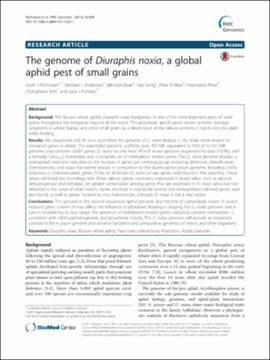| dc.contributor.author | Nicholson, Scott J. | |
| dc.contributor.author | Nickerson, Michael L. | |
| dc.contributor.author | Dean, Michael | |
| dc.contributor.author | Song, Yan | |
| dc.contributor.author | Hoyt, Peter R. | |
| dc.contributor.author | Rhee, Hwanseok | |
| dc.contributor.author | Kim, Changhoon | |
| dc.contributor.author | Puterka, Gary J. | |
| dc.date.accessioned | 2019-08-21T22:01:27Z | |
| dc.date.available | 2019-08-21T22:01:27Z | |
| dc.date.issued | 2015-06-05 | |
| dc.identifier | oksd_nicholson_thegenomeofdiu_2015 | |
| dc.identifier.citation | Nicholson, S. J., Nickerson, M. L., Dean, M., Song, Y., Hoyt, P. R., Rhee, H., Kim, C., & Puterka, G. J. (2015). The genome of Diuraphis noxia, a global aphid pest of small grains. BMC Genomics, 16(1). https://doi.org/10.1186/s12864-015-1525-1 | |
| dc.identifier.uri | https://hdl.handle.net/11244/321195 | |
| dc.description.abstract | Background: The Russian wheat aphid, Diuraphis noxia Kurdjumov, is one of the most important pests of small grains throughout the temperate regions of the world. This phytotoxic aphid causes severe systemic damage symptoms in wheat, barley, and other small grains as a direct result of the salivary proteins it injects into the plant while feeding. | |
| dc.description.abstract | Results: We sequenced and de novo assembled the genome of D. noxia Biotype 2, the strain most virulent to resistance genes in wheat. The assembled genomic scaffolds span 393 MB, equivalent to 93% of its 421 MB genome, and contains 19,097 genes. D. noxia has the most AT-rich insect genome sequenced to date (70.9%), with a bimodal CpG(O/E) distribution and a complete set of methylation related genes. The D. noxia genome displays a widespread, extensive reduction in the number of genes per ortholog group, including defensive, detoxification, chemosensory, and sugar transporter groups in comparison to the Acyrthosiphon pisum genome, including a 65% reduction in chemoreceptor genes. Thirty of 34 known D. noxia salivary genes were found in this assembly. These genes exhibited less homology with those salivary genes commonly expressed in insect saliva, such as glucose dehydrogenase and trehalase, yet greater conservation among genes that are expressed in D. noxia saliva but not detected in the saliva of other insects. Genes involved in insecticide activity and endosymbiont-derived genes were also found, as well as genes involved in virus transmission, although D. noxia is not a viral vector. | |
| dc.description.abstract | Conclusions: This genome is the second sequenced aphid genome, and the first of a phytotoxic insect. D. noxia's reduced gene content of may reflect the influence of phytotoxic feeding in shaping the D. noxia genome, and in turn in broadening its host range. The presence of methylation-related genes, including cytosine methylation, is consistent with other parthenogenetic and polyphenic insects. The D. noxia genome will provide an important contrast to the A. pisum genome and advance functional and comparative genomics of insects and other organisms. | |
| dc.format | application/pdf | |
| dc.language | en_US | |
| dc.publisher | BioMed Central | |
| dc.rights | This material has been previously published. In the Oklahoma State University Library's institutional repository this version is made available through the open access principles and the terms of agreement/consent between the author(s) and the publisher. The permission policy on the use, reproduction or distribution of the material falls under fair use for educational, scholarship, and research purposes. Contact Digital Resources and Discovery Services at lib-dls@okstate.edu or 405-744-9161 for further information. | |
| dc.title | Genome of Diuraphis noxia, a global aphid pest of small grains | |
| osu.filename | oksd_nicholson_thegenomeofdiu_2015.pdf | |
| dc.description.peerreview | Peer reviewed | |
| dc.identifier.doi | 10.1186/s12864-015-1525-1 | |
| dc.description.department | Biochemistry and Molecular Biology | |
| dc.type.genre | Article | |
| dc.type.material | Text | |
| dc.subject.keywords | animals | |
| dc.subject.keywords | aphids | |
| dc.subject.keywords | base composition | |
| dc.subject.keywords | computational biology | |
| dc.subject.keywords | cytosine | |
| dc.subject.keywords | dna methylation | |
| dc.subject.keywords | dna transposable elements | |
| dc.subject.keywords | drug resistance | |
| dc.subject.keywords | epigenesis, genetic | |
| dc.subject.keywords | genetic linkage | |
| dc.subject.keywords | genome, insect | |
| dc.subject.keywords | genomics | |
| dc.subject.keywords | genotype | |
| dc.subject.keywords | insect proteins | |
| dc.subject.keywords | insect vectors | |
| dc.subject.keywords | insecticides | |
| dc.subject.keywords | phylogeny | |
| dc.subject.keywords | rna interference | |
| dc.subject.keywords | repetitive sequences, nucleic acid | |
| dc.subject.keywords | signal transduction | |
| dc.subject.keywords | dna transposable elements | |
| dc.subject.keywords | insect proteins | |
| dc.subject.keywords | insecticides | |
| dc.subject.keywords | cytosine | |
